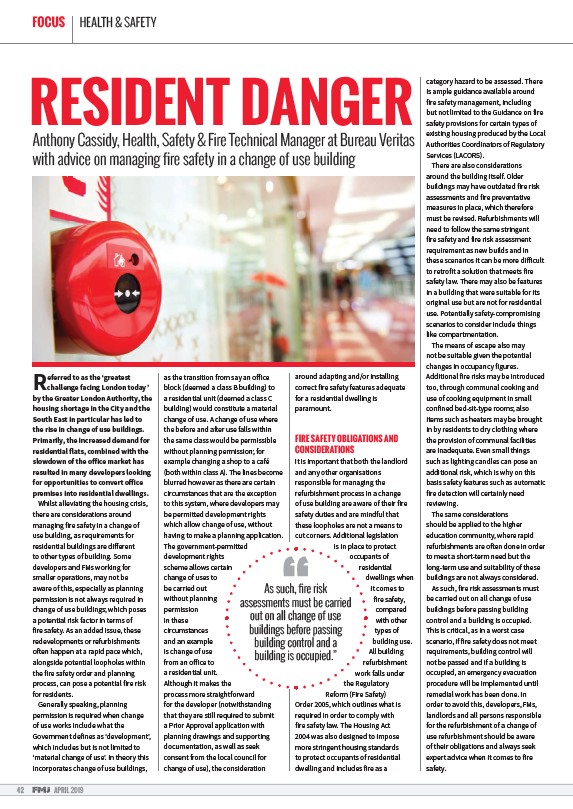
FOCUS HEALTH & SAFETY
RESIDENT DANGER
Referred to as the ‘greatest
challenge facing London today’
by the Greater London Authority, the
housing shortage in the City and the
South East in particular has led to
the rise in change of use buildings.
Primarily, the increased demand for
residential flats, combined with the
slowdown of the o ice market has
resulted in many developers looking
for opportunities to convert o ice
premises into residential dwellings.
Whilst alleviating the housing crisis,
there are considerations around
managing fire safety in a change of
use building, as requirements for
residential buildings are di erent
to other types of building. Some
developers and FMs working for
smaller operations, may not be
aware of this, especially as planning
permission is not always required in
change of use buildings; which poses
a potential risk factor in terms of
fire safety. As an added issue, these
redevelopments or refurbishments
o˜ en happen at a rapid pace which,
alongside potential loopholes within
the fire safety order and planning
process, can pose a potential fire risk
for residents.
Generally speaking, planning
permission is required when change
of use works include what the
Government defines as ‘development’,
which includes but is not limited to
‘material change of use’. In theory this
incorporates change of use buildings,
42 APRIL 2019
as the transition from say an o ice
block (deemed a class B building) to
a residential unit (deemed a class C
building) would constitute a material
change of use. A change of use where
the before and a˜ er use falls within
the same class would be permissible
without planning permission; for
example changing a shop to a café
(both within class A). The lines become
blurred however as there are certain
circumstances that are the exception
to this system, where developers may
be permitted development rights
which allow change of use, without
having to make a planning application.
The government-permitted
development rights
scheme allows certain
change of uses to
be carried out
without planning
permission
in these
circumstances
and an example
is change of use
from an o ice to
a residential unit.
Although it makes the
process more straightforward
for the developer (notwithstanding
that they are still required to submit
a Prior Approval application with
planning drawings and supporting
documentation, as well as seek
consent from the local council for
change of use), the consideration
around adapting and/or installing
correct fire safety features adequate
for a residential dwelling is
paramount.
FIRE SAFETY OBLIGATIONS AND
CONSIDERATIONS
It is important that both the landlord
and any other organisations
responsible for managing the
refurbishment process in a change
of use building are aware of their fire
safety duties and are mindful that
these loopholes are not a means to
cut corners. Additional legislation
is in place to protect
occupants of
residential
dwellings when
it comes to
fire safety,
compared
with other
types of
building use.
All building
refurbishment
work falls under
the Regulatory
Reform (Fire Safety)
Order 2005, which outlines what is
required in order to comply with
fire safety law. The Housing Act
2004 was also designed to impose
more stringent housing standards
to protect occupants of residential
dwelling and includes fire as a
category hazard to be assessed. There
is ample guidance available around
fire safety management, including
but not limited to the Guidance on fire
safety provisions for certain types of
existing housing produced by the Local
Authorities Coordinators of Regulatory
Services (LACORS).
There are also considerations
around the building itself. Older
buildings may have outdated fire risk
assessments and fire preventative
measures in place, which therefore
must be revised. Refurbishments will
need to follow the same stringent
fire safety and fire risk assessment
requirement as new builds and in
these scenarios it can be more di icult
to retrofit a solution that meets fire
safety law. There may also be features
in a building that were suitable for its
original use but are not for residential
use. Potentially safety-compromising
scenarios to consider include things
like compartmentation.
The means of escape also may
not be suitable given the potential
changes in occupancy figures.
Additional fire risks may be introduced
too, through communal cooking and
use of cooking equipment in small
confined bed-sit-type rooms; also
items such as heaters may be brought
in by residents to dry clothing where
the provision of communal facilities
are inadequate. Even small things
such as lighting candles can pose an
additional risk, which is why on this
basis safety features such as automatic
fire detection will certainly need
reviewing.
The same considerations
should be applied to the higher
education community, where rapid
refurbishments are o˜ en done in order
to meet a short-term need but the
long-term use and suitability of these
buildings are not always considered.
As such, fire risk assessments must
be carried out on all change of use
buildings before passing building
control and a building is occupied.
This is critical, as in a worst case
scenario, if fire safety does not meet
requirements, building control will
not be passed and if a building is
occupied, an emergency evacuation
procedure will be implemented until
remedial work has been done. In
order to avoid this, developers, FMs,
landlords and all persons responsible
for the refurbishment of a change of
use refurbishment should be aware
of their obligations and always seek
expert advice when it comes to fire
safety.
Anthony Cassidy, Health, Safety & Fire Technical Manager at Bureau Veritas
Zith aGvice on Panaging fi re safety in a change of Xse EXilGing
$s sXch fi re risN
assessPents PXst Ee carrieG
out on all change of use
EXilGings Eefore passing
EXilGing control anG a
EXilGing is occXpieG.”